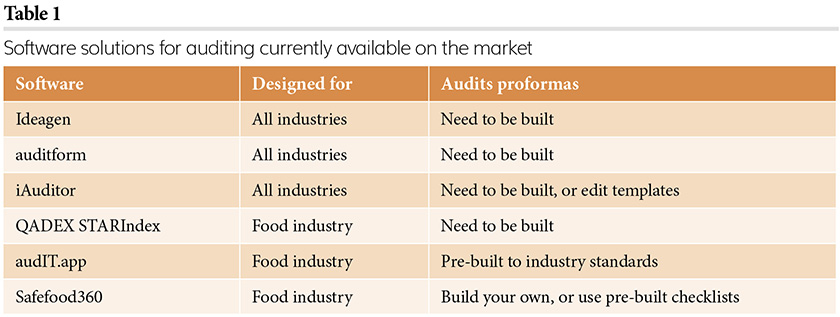The future of food auditing
- Like
- Digg
- Del
- Tumblr
- VKontakte
- Buffer
- Love This
- Odnoklassniki
- Meneame
- Blogger
- Amazon
- Yahoo Mail
- Gmail
- AOL
- Newsvine
- HackerNews
- Evernote
- MySpace
- Mail.ru
- Viadeo
- Line
- Comments
- Yummly
- SMS
- Viber
- Telegram
- Subscribe
- Skype
- Facebook Messenger
- Kakao
- LiveJournal
- Yammer
- Edgar
- Fintel
- Mix
- Instapaper
- Copy Link
Posted: 18 June 2021 | Barbara Bray, Kassy Marsh | No comments yet
Two experts look at how the path of auditing has changed – from initial intentions, to the current situation and what the future likely holds…


If we think back to the inception of the BRC (known most commonly as the BRCGS – the global standard for food safety now), it was a collaboration of interested parties from the food industry, with a shared ambition: to improve standards, provide due diligence and remove the need for repetition of audits.
In this article, we dive into the subject of certification audits, external and internal audits, and consider whether this joint goal has turned out as hoped.
Recent auditing
Although the standards are now more rigorous than they used to be, the purpose of auditing is still the same – to improve standards and provide supply chain due diligence. But we’re a million miles away from where we’d hoped in terms of reducing the number of audits.
As standards have improved, the need for auditing has become more inherent in how we function in the food industry. There has always been a significant gap between the requirements of certification standards in the UK and due diligence required by customers – and that remains the case today. The result of this is that sites continue to host multiple audits to cover certification and meet their customers’ needs.
The range of requirements has also meant that internal audit systems have had to develop and become more complex. Sites are required to audit numerous standards, which presents the ongoing problem of trying to amalgamate a range of ever changing and developing clauses.
The day everything changed
When the pandemic hit, the industry had to adapt – and quickly. Many of the tools and techniques that had been around for a while suddenly became crucial, and we were forced to accept new ways of working. After a brief pause, certification and external audits became at least partially virtual. Sites that were resourced with trained, competent auditors and digital management systems were well placed to adapt to such change, while others, who struggled to cope with internal audits and had to scan handwritten documents, found themselves needing greater resources to manage the virtual audit process.
The future
We cannot predict the future – and we can truly appreciate this fact, having lived through the unprecedented events of the last year – but we can anticipate what it may hold. Yes, this last year has been challenging in many ways, but it would be great if we could take some positives and learnings from the experience. Having a more flexible approach to auditing is certainly one such lesson and we should continue to apply the tools that technology has afforded us. This experience has taught us that technology can improve the way we conduct audits. Internal audit software has been available for some time; but now we can really embrace it.
The last year has also taught us to not be so blinkered in our approach. Just because things have been done a certain way historically, doesn’t mean they always should be. If we were to aim high, what would blue sky auditing look like?
There is a saying, “the best thing about the past is that it shows you what not to bring into the future”. System audits that are based on collecting existing documentation from the management system and comparing it to relevant standards are ideal for virtual audits and it is hard to justify doing those in situ. Digital photography and video have been instrumental in driving improvements in corrective action; especially in hygiene and fabrication audits. Those practices that should be resigned to the past include insufficient dynamic risk assessment for the frequency of auditing, absence of benchmarking across different auditors and departments, and a lack of investigation into recurring non-conformances.
The future presents an opportunity to break away from those habits and leverage technology to analyse the data generated in audits and put it to good use.
Remote auditing technology
Zoom, Microsoft Teams and Google Meet have become a way of life. While it’s true that nothing is quite like being face-to-face, screen sharing provides an ideal straightforward solution for auditing paperwork. Practical audits generally require a more complicated solution, as physical auditing requires many senses, which are difficult to replicate virtually. These include sound and sight.
Factories can be noisy and consequently it can be difficult for a virtual auditor to clearly hear people in the facility. A suitably clear video picture also necessitates a good Wi-Fi signal and high-quality camera. This means, for remote video-based auditing, the right tools are required; smart glasses or augmented reality (AR) glasses are a good solution for this.
Furthermore, given that the skills required by an auditor are quite specific, throwing technology into the mix may entail individuals having to upskill in an area they are not comfortable with. Auditing in teams may be a solution, where an audit team member is sent into the factory with the device for filming and is directed by a more experienced auditor who has a feel of what questions to ask and where to look. The opportunities for training and development in this area are huge.
Internal auditing software
The main benefits of using software to aid the management of an internal audit programme is that admin-heavy tasks can be automated. For example:
- Planning and scheduling of the audit programme
- Issuing of audits and good manufacturing practice (GMP) inspections
- Chasing the completion of audits and GMP inspections
- Issuing and chasing of non-conformances
- Assessment of non-conformances for consequence
- Verification and close out of non-conformances
- KPIs and reporting of audits and non‑conformances
- Risk assessment of the audit programme to determine frequency.
There are several software solutions for auditing currently available on the market (see Table 1).


Table 1
One of the key considerations when choosing the internal audit software is the user experience. Is in-depth knowledge of site procedures necessary for the correct questions to be populated in the template? Or is it ready to use with pre-populated questions and an intuitive platform that groups areas of focus together?
In today’s connected society there are still people who don’t want to engage with new systems and that don’t like change and/or technology; so how can businesses include them and enable successful implementation?
Selling the benefits of technology and removing existing barriers is an important starting point before investing time and energy in new software.
Blue sky auditing
The benefits of video-based auditing allow us to dream a little further. Video allows an audit to be viewed multiple times for multiple purposes. It means that if internal audits were videoed, they can be used as due diligence defence for customers. This would allow customers to view internal audits and come to the same conclusion as the internal auditor. In addition, where a difference of opinion is highlighted, this could trigger further audits or action.
Providing video-based due diligence to customers would then allow them to really focus on their audits and the specifics set out by standards, thus reducing the number and repetition of site audits. Perhaps this could be the solution that we’ve all been looking for?
However, building trust between the site and the customer is crucial to the development of this process. The belief that only the best lines or the main parts of the building are being filmed to avoid awkward questions about other areas is a valid concern. How do you trust that you are being shown everything that is relevant, and how do you handle images and video that shows behaviour or an environment that is not meeting the standard?
A technological solution is great because it solves the problem of information transfer, but for it to be sustainable will require behavioural change between the site’s internal teams, the business and the client, so that we can learn how to use these tools collaboratively and not for personal gain.


Barbara is a TEDx speaker and director of her own consultancy business, Alo Solutions Ltd, driving and delivering food safety in food supply chains and developing sustainable nutrition strategies for food businesses. She is also Co-Founder of the multi-disciplinary platform, Healthy and Sustainable Food, and a director of the Oxford Farming Conference. She is a member of the food and nutrition group at the Institute of Food Science and Technology (IFST) and is a trustee of the Nutrition Society. She speaks at food and agriculture events and has represented the Private Sector Mechanism in speeches at the UN Committee for Food Security in Rome. Prior to consultancy, Barbara worked in the Ugandan agri-business sector after graduation and then spent 14 years in the chilled foods sector in the UK and France. Her roles covered food procurement, technical innovation and implementation of food safety systems. Barbara was runner-up in 2019 and 2020 for the Freelance Nutritionist of the Year awarded by the Caroline Walker Trust; and in 2019 she was awarded an MBE for services to food nutrition. Her latest venture is SCOUT for solutions – a collaborative problem-solving workshop designed to help SMEs in the agri-food sector find new approaches to tackle food and nutrition challenges.


Kassy is the Director of Techni-K, which is best known for its blog that provides free, compliance information on food standards worldwide. Over the past 20 years Kassy has gained a wealth of experience within the food industry – from a student craft baker to QEHS Manager and National Quality Systems Manager for large well-known companies. Kassy specialises in HACCP, QMS Systems and creating methodologies that help the food industry adapt to new developments, which led her to co-publish ‘Assessing Threat Vulnerability for Food Defence’ and ‘Assessing Error Vulnerability for Food Integrity’, and latterly author ‘Combine your HACCP and HARPC plan step by step’.







